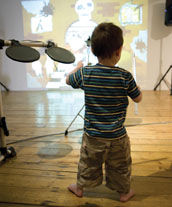Sarah Perks argues that the value of education and engagement programmes cannot be overlooked when cuts are being made

In Danny Boyle’s film ‘127 Hours’, climber Aron Ralston is forced to cut off his own arm to save his life when trapped in a Utah canyon. Jeremy Hunt has stated that he’s very keen for arts organisations not to cut their engagement and education work, despite organisations obviously facing significant budget cuts. Sometimes it seems like the wiser choice is to cut off a part to save the whole body. It is better not to get trapped in the first place, of course, but assuming you’re already there, how can such a vital part be protected? Education and engagement are not the arm – they are part of the heart, or perhaps even the blood. You can lose a little, but you can’t get rid of them completely.
JOINT RESPONSIBILITY
At Cornerhouse we have one team, Programme & Engagement. Everyone is responsible for engagement and we divide the responsibility for events and projects across the team. There are still specialists, particularly our young people’s producer, but that role often works as part of a smaller team to create exhibitions and artworks that unite young people, artists and curators. Our engagement policy has been very strategic for the past few years, strongly focused on 14–19 year olds and a range of adult audiences.
A practical example: we are about to open an exhibition that we have collaboratively produced after an open call inviting both young people and the general public to take part and realise an artist’s idea. The ideas were bought from ‘Unrealised Potential’, a touring project-exhibition that collects unfulfilled artists’ ideas and allows anyone to buy and make them. We workshopped the whole process from choosing the ideas to producing the artworks, deciding the gallery layout to marketing the exhibition and events. The participants chose a title, ‘The People You’re Not’, and drew out themes that connected the three pieces of work created (original ideas by Len Horsey, Ed Barton and comedian Harry Hill).
Audiences want to experience culture in a variety of ways and feel it is presented with them, not for them. Not everyone wants to give up several weekends to produce an exhibition, but many will download a video or podcast, attend a debate or simply have a quick discussion with staff. It is essential that organisations continue to work with audiences to provide access to such experiences.
LEARNING OUTSIDE THE CLASSROOM
It is also important to retain targeted education programmes, such as those for schools, families or disengaged groups. The benefits of these are well evidenced elsewhere, including increased attainment in education, addressing unemployment and audience development. We have just instigated an informal policy where exhibiting artists lead sessions with young people – from Turner Prize winners to emerging, local artists. Actually, most artists want to do this and love the opportunity to work with young people. Artists also want to be very hands-on with the access routes into their work and want to co-curate the education activities alongside the exhibition planning – another reason why the same team develops the full package together.
Perhaps more controversially, I don’t think losing some of the intermediary agencies is a big problem. Schemes like Creative Partnerships often added a layer of bureaucracy, had unsustainable budgets and rarely seemed to equip schools with the necessary resource to initiate projects on their own. Perhaps organisations with a strong track record could receive additional funding to create networks, particularly ones that incorporate freelancers and smaller creative organisations. Large institutions and museums don’t usually need intermediary agencies to set up exciting schools projects, though they may well need financial support for education programmes.
Every organisation needs to find out what works for them. My advice would be to make sure education isn’t a standalone department but a shared responsibility, achieved through a combination of using specialist staff and making education the responsibility of the whole organisation. It has to be truly embedded within the organisation and not a box-ticking exercise. This, in turn, produces stronger relationships with audiences and artists/stakeholders by placing the engagement, participation or interaction with the artwork at the heart of the body rather than the periphery (or out on a limb!).
Education and engagement activities must continue to be supported. Audiences and potential audiences need a range of access points and to be able to engage through various ‘enjoy, talk and do’ experiences with arts and culture. It’s not about explaining a piece of work, be it a play, concert, art installation or film; it’s about realising that the experience is what excites people – and that is achieved by bringing the piece to life.
Sarah Perks is Programme and Engagement Director at Cornerhouse. ‘The Art of With’ essays and reports are available on Cornerhouse’s website. ‘The People You’re Not’ is on 29 Jan–27 Feb at Cornerhouse and
‘Unrealised Potential’ is currently on tour and opens at Void, Derry on 21 Jan.
W http://www.cornerhouse.org/theartofwith
This week Sarah is rooting for Colin Firth to win an Oscar after watching the perfect period drama ‘The King’s Speech’. She also caught National Theatre Live’s Afrobeat spectacular ‘Fela!’ without going to London.



